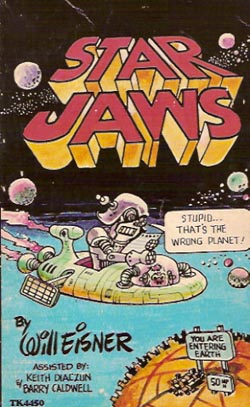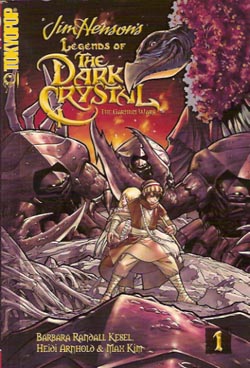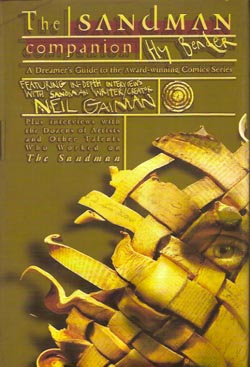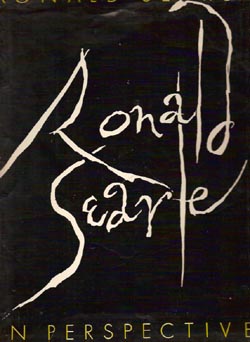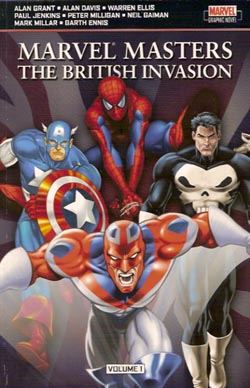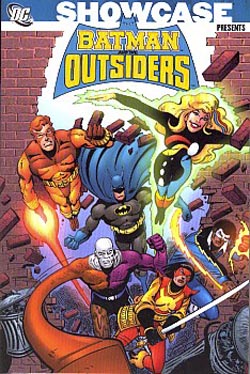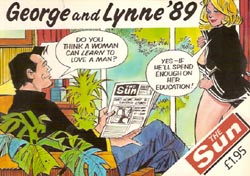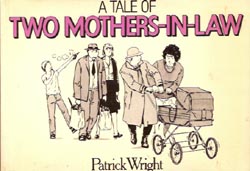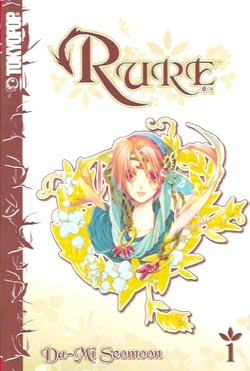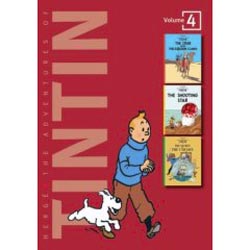
By Hergé (Egmont UK)
ISBN 13: 978-1-4052-2897-8
With this edition of the collected Tintin albums we enter the “Golden Age†of a magnificent creator’s work. Despite being produced whilst Belgium was under the control of Nazi Occupation Forces during World War II, the qualitative leap in all aspects of Hergé’s creativity is tangible.
His homeland fell to the invaders in 1940, and Georges Remi’s brief military career was over. He was a reserve Lieutenant, working on The Land of Black Gold when he was called up, but the swift defeat of Belgium meant that he was back at his drawing board before the year’s end, albeit working for a new paper (since Le Petit Vingtième was closed down) and on a brand new adventure. He would not return to the unfinished ‘Black Gold’ with its highly anti-fascistic subtext, until 1949.
Instead, now established in Le Soir (Belgium’s premiere daily newspaper and a most valuable tool for the occupiers to control) Hergé began the first of six extraordinary tales of light-hearted, escapist thrills, with strong plots and deep characterisation that created a haven of delight from the daily horrors of everyday life then and remain a legacy of joyous adventure to this day.
The Crab with the Golden Claws ran from 1940 to 1941 (the edition collected in this fabulous little hardback was first re-mastered in 1953 by Studio Herg̩) and opens with Snowy getting his head caught in an empty crab-meat can whilst scavenging in a trash bin. When Tintin meets the detectives Thompson and Thomson they discuss their latest case and he sees that a vital piece of evidence is a torn label from a crab-meat tin Рand it matches the torn label on the can that he so recently extricated his bad dog from!
And so begins a superb mystery adventure as Tintin follows his lead to the sinister freighter “Karaboudjan†where he is nearly murdered before the diabolical Mate “Allan†(last seen in Cigars of the Pharaoh – Adventures of Tintin: Volume 2, ISBN 13: 978-1-4052-2895-4) shanghais him. It is whilst a prisoner that the boy reporter meets a drunken reprobate who would become his greatest companion: The ship’s inebriated Master, Captain Haddock.
Escaping together, they eventually reach the African Coast, with Haddock’s dipsomaniac antics as much a threat to the pair as the gangsters, ocean storms, and deprivation. These trials are masterpieces of comedy cartooning that have never been surpassed. Despite all odds the heroes survive sea, sands and scoundrels to link up with the military authorities. Making their way to Morocco they track down the criminals to reveal a huge opium smuggling operation. A fast-paced tour-de-force of art and action, liberally laced with primal comedy and captivating exotic locales, this is quite simply mesmerising fare.
The Shooting Star was one of the first tales to be re-issued after World War II, due no doubt to its relatively escapist plot. Originally running from 1941-1942 it is practically an old-fashioned pulp thriller. The world is gripped in terror as a fiery meteor is detected hurtling towards Earth. The apocalypse is averted only by the sheerest chance, as the heavenly body narrowly misses Earth, although when a relatively small chunk breaks off, scientists find that it contains an unknown metal of immense potential value. And so begins a fantastic race to find and claim the fallen meteorite.
A party of European scientists charters the survey ship “Auroraâ€, with Captain Haddock commanding and Tintin aboard as official Press representative. Frantically sailing north to the Pole, they discover that they are in competition with the unscrupulous forces of the evil capitalists of the Bohlwinkel Bank, whose rival expedition uses every dirty trick to sabotage or delay the scientists.
After a truly Herculean effort and by sheer dint of willpower – not to say spectacular bravery – Tintin is the first to claim their floating prize and successfully defend it from the villainous Bohlwinkel crew, but the star itself is a menace as its mysterious composition induces monstrous gigantism. Tintin and Snowy must survive assaults by mutated insects and plants before the breathtaking conclusion of this splendid tale.
After the dramatic if far-fetched exploits of The Shooting Star, Hergé returned to less fantastical fare with The Secret of the Unicorn (re-mastered in 1946, this originally ran from 1942-1943). Tintin buys an antique model galleon at a street market, intending to give it to Captain Haddock, but even before he can pay for it an increasingly desperate number of people try to buy, and even steal it from him. Resisting all efforts he presents it to his friend ‘though not before a minor accident breaks one of the masts. The Captain is flabbergasted! He has a portrait of his ancestor Sir Francis Haddock, painted in the reign of King Charles II, in which the exact same ship features!
When he returns home Tintin finds the model has been stolen but on visiting the first and most strident of the collectors who tried to buy it from him he discovers that the man already has an exact duplicate of the missing model. After much hurly-burly Tintin and Haddock find that Sir Francis was once a prisoner of the pirate Red Rackham, but escaped with the location of the villain’s treasure horde. Subsequently making three models of his vessel “The Unicornâ€, he placed part of a map in each and gave them to his three sons…
Someone else obviously knows the secret of the model ships and that mysterious mastermind becomes ever more devious and ruthless in his attempts to obtain the complete map. Events come to a head when Tintin is kidnapped, which is a big mistake, as the intrepid lad brilliantly turns the tables on his abductors and solves the mystery. With the adventure suitably concluded, the volume ends with our heroes ready to embark on the no-doubt perilous voyage to recover ‘Red Rackam’s Treasure’…
For which we must turn to the next volume in this glorious repackaging of one of the World’s greatest comic strip treasures… Hergé’s Adventures of Tintin!
The Crab with the Golden Claws: artwork © 1953, 1981 Editions Casterman, Paris & Tournai. Text © 1958 Egmont UK Limited. All Rights Reserved.
The Shooting Star: artwork © 1946, 1974 Editions Casterman, Paris & Tournai.
Text © 1961 Egmont UK Limited. All Rights Reserved.
The Secret of the Unicorn: artwork © 1946, 1974 Editions Casterman, Paris & Tournai.
Text © 1959 Egmont UK Limited. All Rights Reserved.

